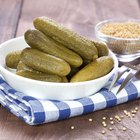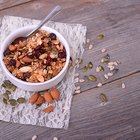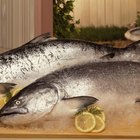
A spreading interest in healthy eating has enhanced the nutritional reputation of fresh over canned food. A ripe, just-picked peach certainly looks as though it must offer more vitamins and overall nutrition than its canned counterpart. In many cases, however, canned foods offer comparable nutrition and greater dietary diversity, especially to families with tight food budgets or limited access to fresh markets. Balance the benefits of canned and fresh food when planning healthy meals.
Fresh Food Benefits
At their peak, fresh fruits and vegetables contain vitamins and minerals essential to human health. Cornell University studies indicate that phytochemicals available in fresh produce are more effective in disease prevention than even mega-doses of single vitamins. In its natural state, produce offers maximum fiber and benefits of nutrients found in and close to the outer peel. Cooking with fresh meat lets you regulate the fat content through trimming and the method of preparation. There are noticeable taste differences between fresh and canned milk products. Coordinating your cooking with seasonal cycles lets you incorporate berries, greens, seafood and other foods in your diet at their freshest and most nutritious.
Fresh Food Concerns
In many ways, what you see is what you get when you buy fresh food. Your senses of sight, smell and touch all help you evaluate the freshness of food, but they have their limits. What your senses can't tell you is the exact nutrient content of the fresh foods you buy. Out-of-season strawberries may look red, glossy and unblemished but taste dull and watery if they were greenhouse-grown and traveled long distances to market. Even at the height of tomato season, heirlooms may appear only in local farmer's markets because they are hard to grow and ship in supermarket quantity. Prepackaging prevents you from evaluating the freshness of meat by smell until you open it at home. Well-tended produce can look good for a week or more on store shelves while losing vitamins to oxidation daily.
Canned Food Benefits
Historically, canning technology was developed to prevent seasonal starvation. One of the biggest benefits of canned food is consistency. Unlike fresh food, canned foods are available year-round. Commercial canners are able to demand growing and picking procedures that provide them with peak-fresh seasonal produce. U.S. Department of Agriculture nutritional labeling lets purchasers know what they are buying. Commercial volume often means canned foods are less expensive than fresh. Shelf rather than refrigerator storage can be a further savings and can expand the diets of those with limited refrigeration and cooking facilities. Canning, whether commercial or done at home, can also extend the variety of foods available to customers. Most shoppers buy canned tuna, salmon, sardines, pineapple, tomatoes and olives with little or no thought to their origins. Prepared foods ranging from soups to cooking stocks to pickles, jams and peanut butter further enlarge daily meal and nutrition choices.
Canned Food Nutrition
Canned foods may differ in nutrient quality from fresh ones but not necessarily because of processing. According to studies at Michigan State University and the University of California at Davis, canning may decrease levels of vitamin C and other water-soluble vitamins in fruits and vegetables, but loss ceases once processing is complete. Vitamin loss continues in both fresh and frozen produce because of continued exposure to oxidation. Some B vitamins and oil-soluble vitamins like vitamins A and E are little affected by the canning process. Precise comparisons between fresh and canned nutrient content is difficult for most foods because of high variability in the harvesting, transport and storage of fresh items.
Other Canned Food Concerns
Other major objections to heavy reliance on canned foods relate to preparation rather than processing. Commercial canners have responded to concerns about sodium levels in canned vegetables with methods that permit safe low- or no-salt processing. High sodium levels in soups, sauces and other prepared canned foods can be ascribed as much to customer taste preferences as to production needs; adding salt is a cheap way to add flavor. The same complexity applies to the sugar content of many canned foods. Commercial producers have expanded choices, such as juice-packed fruit, to allow customers to better control sugar intake. It remains up to the consumer to make healthy choices.
Related Articles

The Advantages of Pickling Foods

The Effect of Food Processing on ...

Does Boiling Fruits Destroy Vitamins?

Hydroponic Vegetable Nutrients Vs. ...
How Long After the Expiration Date Can ...

Does Freeze-Drying Affect Nutrition?

How Are Strawberries Processed?

Farm-to-Table Concept

Are Pickled Vegetables Allowed on a Raw ...

Canned Salmon and Metal Toxins

How to Dry Blueberries in a Dehydrator
Is There a Loss of Nutritional Value in ...

Advantages of Vermicompost

Health Benefits of Organic Foods Vs. ...

Organic Vs. Conventional Olive Oil

Examples of Green Products
Maximum Storage Temperature of Canned ...

How Many Calories Are in 1 Tablespoon ...

List of Biodegradable, Every Day ...

How to Store Brussels Sprouts
References
- The New York Times: Really? The Claim: Fresh Produce Has More Nutrients than Canned
- Best Food Facts: Fresh, Frozen, Canned, Dehydrated: Healthy Eating Year-Round
- Michigan State University: Nutrition & Costs Comparisons of Select Canned, Frozen and Fresh Fruits and Vegetables
- Steel Marketing Development Institute: Nutritional Comparison of Fresh, Frozen and Canned Foods
- WebMD: An Apple a Day May Really Keep the Doctor Away
Resources
Writer Bio
Janet Beal has written for various websites, covering a variety of topics, including gardening, home, child development and cultural issues. Her work has appeared on early childhood education and consumer education websites. She has a Bachelor of Arts in English from Harvard University and a Master of Science in early childhood education from the College of New Rochelle.
Photo Credits
Jupiterimages/Brand X Pictures/Getty Images